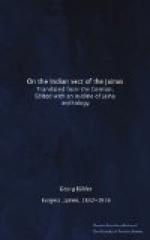The formulae of the inscriptions are almost universally the same. First comes the date, then follows the name of a reverend teacher, next, the mention of the school and the subdivision of it to which he belonged. Then the persons, who dedicated the statues are named (mostly women), and who belonged to the community of the said teacher. The description of the gift forms the conclusion. The dialect of the inscriptions shows that curious mixture of Sansk[r.][)i]t and Prak[r.][)i]t which is found in almost all documents of the Indo-Skythian kings, and whichas Dr. Hoernle was the first to recognise—was one of the literary languages of northern and northwestern India during the first centuries before and after the commencement of our era.
In the calculation of dates, I use the favourite starting point for the era of the Indo-Skythian kings, which unfortunately, is not certainly determined, and assume that it is identical with the Saka era of 78-1/4 A.D. The rule of these princes could not have fallen later: in my opinion it was somewhat earlier. [Footnote: What follows is from the author’s later and fuller paper in Wiener Zeitschrift fuer die Kunde des Morgenlandes, Bd. I, S. 170 f., but abridged.—Ed.] I give here transcripts and restorations of such inscriptions as mention Jaina schools or titles.
1. The inscription which is the most important for my purpose and at the same time one of the best preserved, is Sir A. Cunningham’s No. 6, plate xiii, which was found on the base of a Jaina image (Arch. Sur. Rep. vol. III, p. 31). The copy compared with a rubbing gives the following reading, (the letters within parentheses are damaged):
L. 1. Siddha[.m] sa[.m] 20 grama 1
di 10 + 5 ko([t.]i)yato ga[n.]ato
(Va)[n.]iyato kulato V(ai)r(i)to [’s]akato
[’S]irikato
2. (bha)ttito vachakasya Aryya-Sa[.n]ghasihasya
nir(v)varttana[.m]
Dattilasya.... Vi.-
3. lasya ko([t.]hu)bi(ki)ya Jayavalasya
Devadasasya Nagadinasya cha
Nagadinaye cha (ma)tu.
4. [’s]ra(vi)kaye (D)i-
5. (na)ye dana[.m]. i
6. Varddhamana pra-
7. tima|
The lacuna in line 2, after Dattilasya, probably contained the word duhituye or dhutuye and part of a male name of which only the letter vi is visible. In l. 3, possibly ko[t.]habiniye is to be read instead of ko[t.]hubikiye. As there is room for one more letter at the end of the line, I propose to read matuye. In l. 5, Dinaye would stand for Dattaya[h.] and be the genitive of a female name Dinna or Datta, which has been shortened bhamavat. There can be no doubt that the word [’s]ri, or [’s]iri, which is required, has stood before Vardhamana. With these restorations the translation is as follows:




